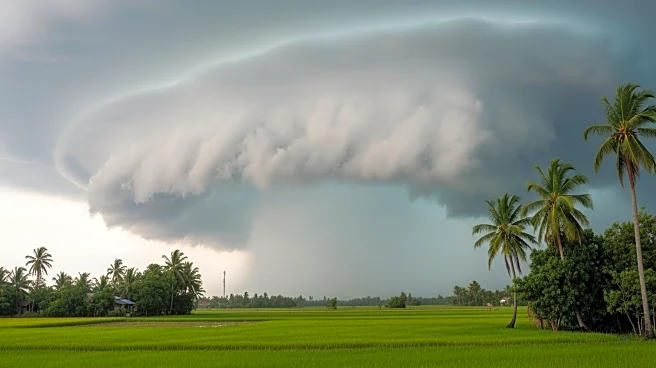What's Happening?
The Philippines is facing a severe weather threat as Super Typhoon Fung-wong approaches the northeastern coast. The typhoon, with winds reaching up to 115 mph and gusts of 143 mph, is expected to make
landfall soon, prompting the evacuation of nearly a million people from high-risk areas. This comes in the wake of Typhoon Kalmaegi, which recently caused significant devastation, leaving at least 224 people dead. President Ferdinand Marcos Jr. has declared a state of emergency due to the extensive damage from Kalmaegi and the anticipated impact of Fung-wong. The typhoon's wide rain and wind band could affect two-thirds of the archipelago, including the densely populated capital region of Manila.
Why It's Important?
The arrival of Super Typhoon Fung-wong poses a significant threat to the Philippines, a country already prone to natural disasters. The potential impact on millions of residents, infrastructure, and the economy is substantial. The evacuation of nearly a million people highlights the urgency and scale of the threat. The typhoon could disrupt daily life, with schools and government offices preemptively closed and flights canceled. The situation underscores the vulnerability of the Philippines to extreme weather events, exacerbated by climate change, and the need for robust disaster preparedness and response strategies.
What's Next?
As the typhoon approaches, authorities are focused on ensuring the safety of residents in high-risk areas. The government has warned of life-threatening storm surges and flooding, urging people to evacuate promptly. The United States and Japan have offered assistance, although international aid has not yet been requested. The aftermath of the typhoon will likely require significant recovery efforts, including rebuilding infrastructure and providing support to affected communities. The ongoing threat of natural disasters in the region may prompt further discussions on climate resilience and disaster management strategies.
Beyond the Headlines
The frequent occurrence of typhoons in the Philippines highlights broader issues related to climate change and environmental sustainability. The country's geographic location makes it particularly vulnerable to extreme weather, necessitating ongoing investment in disaster preparedness and climate adaptation measures. The impact of such events on the economy, public health, and social stability is profound, emphasizing the need for comprehensive policies that address both immediate and long-term challenges.













